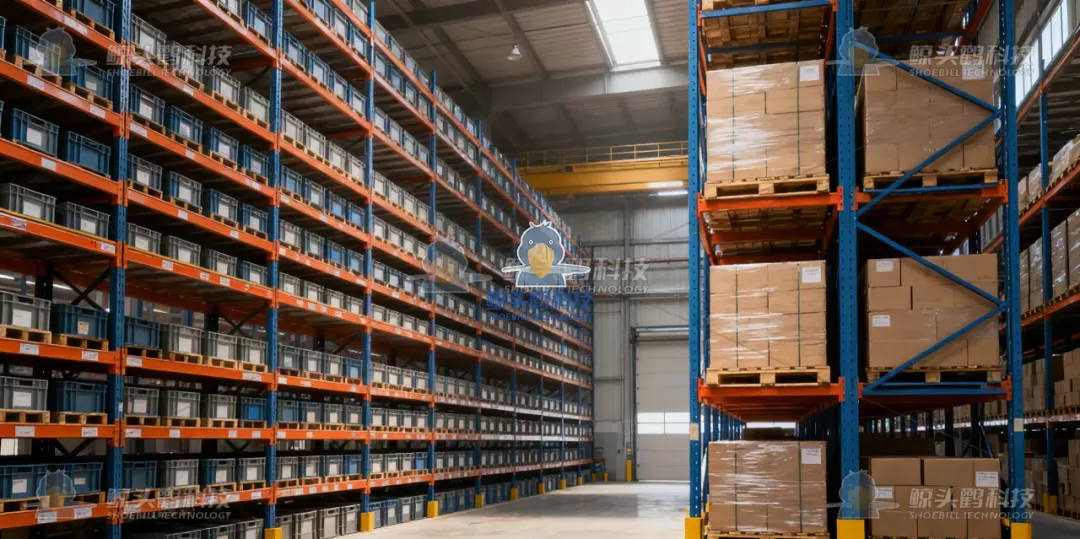In the age of intelligent manufacturing, the fusion of logistics warehouse planning and inventory optimization has become a cornerstone for achieving lean, responsive, and sustainable supply chains. With the rise of smart logistics warehouse solutions and advanced warehouse technology, companies are moving beyond traditional storage management to create adaptive, data-driven warehouse ecosystems. Shoebill Technology exemplifies this transformation through its integrated planning strategy that unites precise warehouse design, inventory turnover optimization, and digital intelligence for maximum operational efficiency.
Logistics Warehouse Planning for Intelligent Supply Chains
In modern manufacturing environments, logistics warehouse planning is no longer confined to space allocation. It has evolved into a comprehensive process involving data analytics, demand forecasting, and process simulation. Shoebill Technology approaches warehouse planning with the principle of “optimal storage and efficient turnover,” leveraging detailed calculations to align material flow with real-time production demands.
The company evaluates parameters such as material dimensions, daily demand, packaging cycle, and turnover days to accurately estimate the required storage capacity and warehouse footprint. For instance, in a line-control workshop, Shoebill Technology planned three automated warehouses with storage needs of 85, 200, and 383 locations respectively. Each warehouse operates at output and input frequencies of 4, 9.5, and 18 times per hour. The warehouse layout is engineered according to material specifications, with location dimensions such as 1280×1180×1300 mm, ensuring that material storage and handling remain both efficient and flexible.
This scientific approach to warehouse planning enables Shoebill Technology to maintain a perfect balance between logistics efficiency and storage precision, achieving higher throughput and better synchronization with production lines.
Smart Logistics Warehouse Design for Adaptive Operations
A smart logistics warehouse integrates automation, digitalization, and intelligent control systems to streamline every movement of materials—from inbound reception to outbound dispatch. Shoebill Technology’s smart warehouse solutions employ automated storage and retrieval systems (AS/RS), RFID tracking, and real-time monitoring to optimize logistics operations.
The smart warehouse design focuses on four key pillars:
Automation and Robotics – Using AGVs (Automated Guided Vehicles) and robotic picking systems to minimize manual labor and improve accuracy.
Data Connectivity – Integrating warehouse management systems (WMS) with manufacturing execution systems (MES) for seamless data flow.
Dynamic Space Utilization – Adapting warehouse configurations based on inventory type and production schedule.
Real-Time Visibility – Monitoring material movements and warehouse occupancy through IoT sensors and digital dashboards.
By adopting such intelligent designs, Shoebill Technology’s logistics warehouses support Just-In-Time (JIT) supply principles, enabling production lines to receive materials exactly when needed while minimizing idle inventory.

Warehouse Technology Solutions Driving Efficiency
The heart of a smart logistics warehouse lies in the deployment of advanced warehouse technology solutions. Shoebill Technology’s system integrates digital twins, simulation modeling, and AI-based decision algorithms to forecast demand and optimize material flow paths.
For example, when designing warehouses for raw materials and empty containers, Shoebill Technology calculated a turnover cycle of 4 days, while finished goods and empty containers are managed on a 1.5-day turnover basis. This cycle design dramatically enhances inventory circulation and reduces the capital tied up in raw materials.
Additionally, by analyzing the logistics relationship strength between workshops (for example, a welding workshop with a logistics equivalent of 356.9 with raw material and finished goods warehouses), Shoebill strategically locates warehouses near high-intensity workshops. This proximity reduces transport distances, shortens delivery times, and lowers logistics costs—achieving synergy between production and storage.
Inventory Optimization through Smart Warehouse Management
Inventory optimization is not only about minimizing storage costs; it is about creating an agile system that adapts to production rhythms. Shoebill Technology applies data-driven inventory management models that combine warehouse analytics with real-time consumption data.
Through JIT delivery and digital forecasting, Shoebill reduces redundant inventory, shortens supply lead times, and enhances the overall responsiveness of the supply chain. Automated high-bay warehouses allow for denser storage, while intelligent scheduling ensures materials flow in alignment with production demand.
This approach results in:
Higher turnover rates through lean inventory control.
Lower warehouse footprint without compromising material accessibility.
Reduced production interruptions due to optimized replenishment cycles.
The company’s integration of smart logistics warehouse management with inventory optimization showcases how technology can achieve both operational efficiency and strategic flexibility.
Integrating Warehouse Layout with Production Logistics
Warehouse planning is most effective when it supports production logistics holistically. Shoebill Technology designs its logistics network based on logistics intensity mapping, which identifies the frequency and volume of material exchanges between facilities.
By positioning warehouses adjacent to high-flow workshops, Shoebill minimizes internal logistics complexity. For instance, materials for the welding workshop are stored in proximity to production lines to streamline material supply and retrieval. This alignment reduces travel time for AGVs, enhances synchronization with production schedules, and ensures a continuous material flow across all manufacturing units.
Such integration between warehouse layout and production operations represents a fundamental principle in smart logistics warehouse planning, enabling factories to operate at peak efficiency with minimal waste.
Future of Logistics Warehouse Planning and Technology
The future of logistics warehouse planning is undeniably smart, data-centric, and sustainable. With AI, digital twins, and predictive analytics becoming mainstream, warehouse management is shifting from reactive control to proactive decision-making.
Shoebill Technology’s vision of “optimal storage and efficient turnover” reflects a forward-looking commitment to building intelligent, flexible, and sustainable warehouse ecosystems. As industrial supply chains evolve toward Industry 5.0, warehouse technology solutions will not only manage goods but also orchestrate complex data-driven ecosystems that learn and adapt continuously.
The convergence of smart logistics warehouse systems and inventory optimization strategies will redefine operational excellence, allowing manufacturers to respond faster, operate leaner, and achieve higher profitability through intelligent warehouse integration.
Conclusion
The efficient integration of logistics warehouse planning and inventory optimization marks a significant leap toward intelligent manufacturing. Through precise design, automated systems, and data-driven decision-making, Shoebill Technology sets a benchmark in creating responsive and high-efficiency warehouse ecosystems.
By leveraging smart logistics warehouse solutions and advanced warehouse technology, enterprises can transform their logistics operations into agile, adaptive networks—achieving not only cost efficiency but also strategic competitiveness in a fast-evolving industrial landscape.










